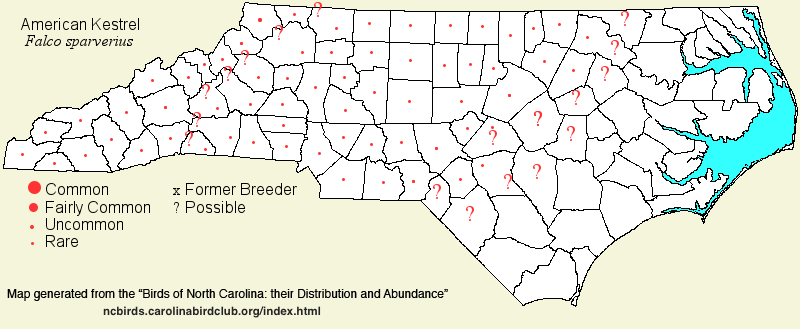 |  |
|
American Kestrel - Falco sparverius FALCONIDAE Members: | Search Common: Search Scientific: |
|
|
|||||||
| General Comments | The American Kestrel is the state's most widespread falcon, and it breeds across much of both North and South America. However, populations in the eastern part of North America have shown alarming declines since at least 1980. The decline might be attributable to pesticides, loss of farmland habitat in the Northeast, and inter-specific competition for nesting cavities. Whereas dozens could often be seen per day on the Outer Banks in fall and winter in the 1960's and 1970's, only a few birds can be seen now in a day, even in fall. Wintering numbers across the state are also down over 50% during this period. On the other hand, the species has always been inexplicably scarce as a breeder, despite seemingly suitable conditions of extensive fields and pastures. In fact, a handful of pairs breed inside city limits, in urban areas! Kestrels are characteristically seen perched on telephone wires and other conspicuous perches, in fields, pastures, and coastal grasslands/dunes. | ||||||
| Breeding Status | Breeder | ||||||
| NC BRC List | Definitive | ||||||
| State Status | SR | ||||||
| U.S. Status | |||||||
| State Rank | S2B,S5N | ||||||
| Global Rank | G5 | ||||||
| Coastal Plain | Transient and winter resident, declining; scarce and sporadic breeder. Formerly common to abundant fall migrant along the coast, but now only fairly common to occasionally common (after a strong cold front); fairly common to common in winter in the Tidewater area and along and near the coast. Farther inland, fairly common in winter. Rare to very uncommon, regular breeder at Fort Bragg, where it inhabits drop zones and impact areas, or other very open stands of longleaf pines. Casual to very rare, and erratic, as a breeder elsewhere, mainly in the far western portions. Primary occurrence period: late Aug to early May. Peak counts: 158, Ocraocke Island, 20 Sep 1995. | ||||||
| Piedmont | Permanent resident, with migratory movements, declining; however, mainly a winter resident. Formerly, fairly common to common in winter, but now mostly uncommon, slightly more numerous in the eastern region. Rare breeder, seemingly mainly in the western portion. Nests both in downtown/urban areas in cities, as well as around large farmlands, where inexplicably scarce in the breeding season (as birds winter routinely in such areas). Mainly mid-Sep to late Apr. Peak counts: ? | ||||||
| Mountains | Permanent resident, with migratory movements; declining. Fairly common fall migrant, but mostly uncommon (at best) in winter, and more so at lower elevations (below 2,500 feet). Rare to very uncommon breeder, at a variety of elevations. Peak counts: | ||||||
| Finding Tips |
It is still easily found in winter around large fields in the eastern part of the state, such as near Lake Mattamuskeet. However, the decline continues, and it can often now be missed in a day of birding in many other areas of the state in fall and winter. *** to **** | ||||||
| Attribution | LeGrand[2023-03-23], LeGrand[2015-02-20], LeGrand[2012-05-19] | ||||||
| NC Map Map depicts all counties with a report (transient or resident) for the species. | Click on county for list of all known species. |
| NC Breeding Season Map Map depicts assumed breeding season abundance for the species. |  |